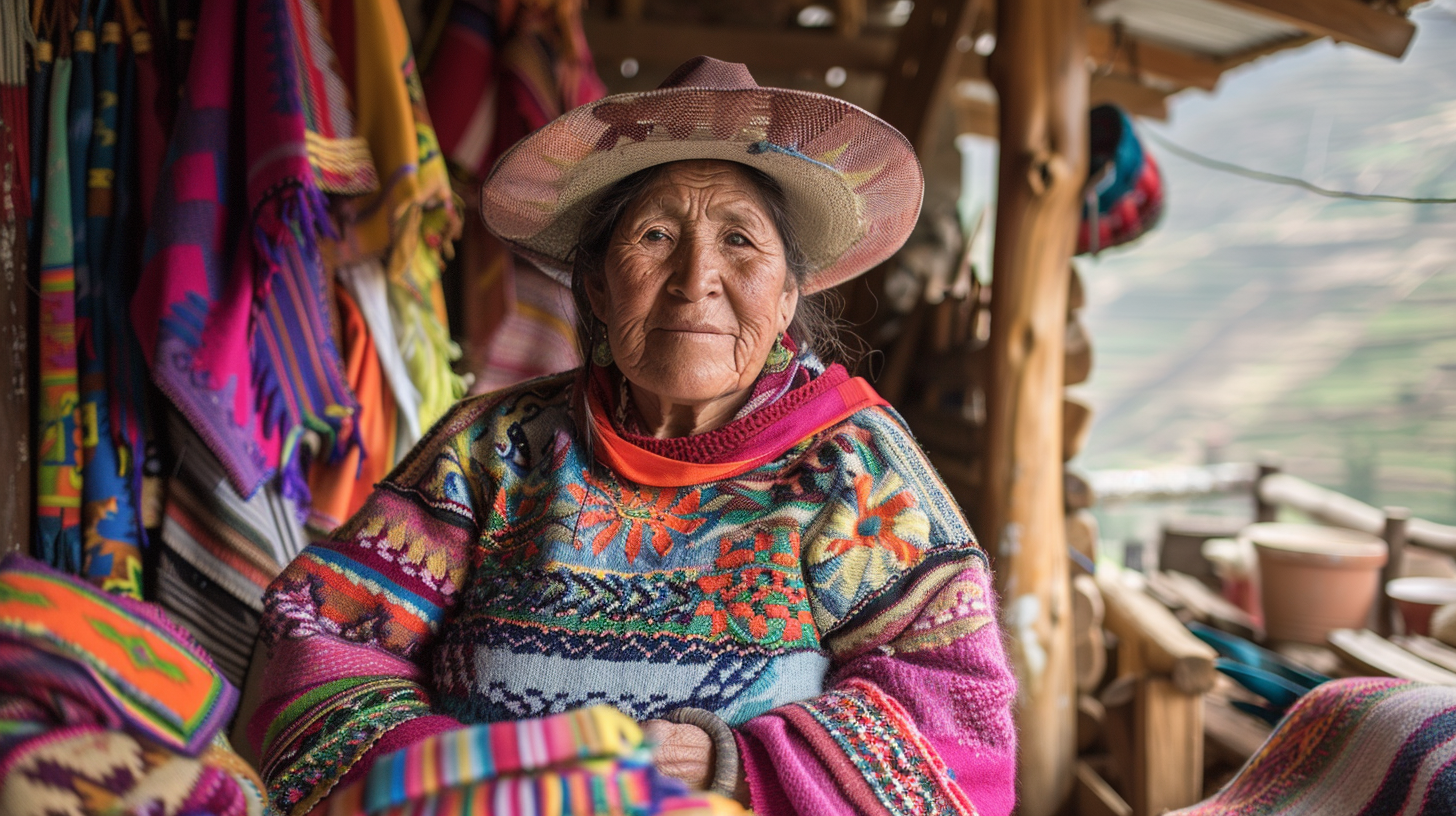Table of Contents Show
Just as threads intertwine to form a tapestry, so do textiles weave together the stories of our cultures and histories. We find ourselves fascinated by how traditional weaving acts as a mirror, reflecting the intricacies of societal values, beliefs, and identities across generations. It’s not just about the fabric itself, but the hands that craft it, the stories it tells, and the legacy it carries. Exploring this rich tapestry, we’ll uncover the symbolism in patterns and the significance of textiles in rituals and traditions. Join us as we unravel the layers of meaning behind these cultural artifacts, revealing insights into our collective past.
Key Takeaways
- Textiles and weaving encapsulate cultural identities and histories through symbolic patterns and techniques.
- Traditional weaving techniques are pivotal in preserving cultural heritage and fostering community engagement.
- Weaving traditions across the globe showcase the diversity and richness of cultural expressions and environmental connections.
- Reviving and teaching traditional weaving skills bridges generational gaps, ensuring cultural preservation and social cohesion.
The Essence of Weaving
Weaving, at its core, intertwines cultural stories and traditions, crafting textiles that go beyond mere fabric. It’s a validation of the ingenuity and creativity of people who’ve long since understood the importance of preserving their heritage through threads and colors. We’re talking about an art form that’s as ancient as it is vibrant, offering us a glimpse into the lives and values of societies long gone and those that still cherish these practices today.
For us, embracing weaving means acknowledging a world where freedom of expression isn’t just spoken but is woven into the very fabric of our lives. It’s about understanding that each pattern, each thread, tells a story of struggles, triumphs, and the enduring spirit of a community. We’re not just looking at textiles; we’re seeing the embodiment of cultural identity and the resilience of traditions that refuse to be forgotten.
We’re captivated by the way weaving brings together communities, fostering a sense of belonging and continuity. It’s a craft that demands patience, skill, and a deep connection to the past, yet it’s perpetually evolving, influenced by the hands that work the loom and the stories they choose to tell. This isn’t just about preserving what was; it’s about creating a space where new narratives can flourish alongside the old, where freedom to explore and innovate is woven into each piece.
Historical Significance
Throughout history, textiles have served as a vivid testament, capturing the essence of civilizations and their intricate journey through time. They’re not just fabric; they’re a canvas where societies have painted their innovations, beliefs, and traditions. We’ve seen this time and again, where the threads and colors used in textiles tell us much more than just the fashion of the time—they reveal the story of human progress and cultural exchange.
Here’s how textiles have historically marked significant milestones:
-
Trade and Economy: Textiles have been at the heart of trade routes, like the famous Silk Road, fostering economic relationships between distant cultures. They didn’t just carry goods; they wove together the economies of the world, providing a means for societies to flourish.
-
Technological Advancements: The development of textiles has spurred technological innovations, from the spinning wheel to the loom. These advancements weren’t confined to the textile industry; they’ve been pivotal in the broader narrative of human achievement.
-
Social Hierarchies: Different fabrics and patterns have symbolized social and economic status, marking the distinction between royalty and commoners. This distinction has painted a vivid picture of societal structures and norms across different periods.
-
Historical Events and Movements: Textiles have chronicled significant events, such as revolutions and cultural movements. Flags, uniforms, and symbolic clothing have rallied people together, serving as emblems of unity and identity in the face of adversity.
We’re reminded that our ancestors’ legacy is woven into the very fabric of our daily lives, offering a tangible link to the past that we carry into the future. It’s a demonstration of our shared human experience, capturing the spirit of freedom and the relentless pursuit of progress.
Cultural Identity Through Textiles
We now turn our attention to how textiles embody cultural identity, starting with the rich symbolism found in weaving patterns. These textiles serve as keepers of heritage, carrying the stories and traditions of many generations. Moreover, the modern revival of these traditions highlights an ongoing commitment to preserving our collective cultural legacy.
Symbolism in Weaving Patterns
Many cultures embed profound meanings and identities within the intricate patterns of their traditional textiles. These designs aren’t just for decoration; they’re a language of their own, telling stories of heritage, beliefs, and aspirations. We see ourselves as part of this fabric, weaving our past into the present and future.
Here’s how symbolism in weaving patterns reflects our cultural identity:
- Colors represent emotions and natural elements, connecting us to our environment and inner selves.
- Geometric shapes symbolize balance and harmony, guiding our lives towards equilibrium.
- Animals and plants illustrate our relationship with nature, reminding us of our dependence and respect for the earth.
- Historical events and myths are depicted, preserving our collective memory and teaching future generations.
Through these patterns, we’re not just making textiles; we’re crafting the story of who we are.
Textiles as Heritage Keepers
Textiles serve as the keepers of our cultural heritage, narrating the rich tapestry of our collective identity through every thread and color. We weave our stories, beliefs, and history into these fabrics, making them more than mere materials. They’re living, breathing embodiments of our past, connecting us to our ancestors and the lands from which we hail.
| Region | Textile | Significance |
|---|---|---|
| Asia | Silk | Symbol of wealth and status |
| Africa | Kente Cloth | Representation of identity |
| South America | Aguayo | Community and tradition |
These textiles are not just artifacts; they’re vibrant expressions of freedom, allowing us to celebrate and preserve our unique cultures. Through them, we maintain our connection to traditions, ensuring they’re not lost but instead, passed down through generations, keeping our cultural identity alive and thriving.
Modern Revival of Traditions
In recent years, there’s been a significant resurgence in embracing traditional weaving techniques, showcasing how cultural identity continues to be expressed and preserved through textiles. We’re witnessing an inspiring movement where:
- Artisans are blending age-old practices with modern aesthetics, creating pieces that resonate with today’s audiences while honoring their roots.
- Communities are rallying to support local weavers, recognizing the value of sustaining these crafts for future generations.
- Educational programs are emerging, aimed at teaching the youth the skills and significance of traditional weaving, ensuring its survival.
- Social media platforms have become a powerful tool for artisans to share their stories and connect with a global audience, spreading awareness and fostering a sense of pride in one’s heritage.
This revival isn’t just about preserving the past; it’s a declaration of our identity, woven into the very fabric of our future.
Techniques Across Generations
We’ve explored how textiles serve as a vessel for cultural identity, and now we’ll examine how weaving techniques have evolved over generations. From heritage weaving methods to modern adaptations, we’ll see how these ancient crafts have been preserved and transformed. It’s fascinating to observe how tradition and innovation intersect in the domain of textile art.
Heritage Weaving Methods
Heritage weaving methods, passed down through generations, have become cornerstones of cultural identity and craftsmanship. We’ve embraced the freedom to express through threads and looms, weaving tales of our ancestors into the fabric of today. These techniques, rich in history, tell stories of resilience, innovation, and artistry. Here’s a glimpse into the diversity of our heritage:
- Backstrap Loom Weaving: A personal journey of skill, allowing the weaver to control tension with their body.
- Tapestry Weaving: Crafting intricate narratives through pictorial designs.
- Ikat Dyeing and Weaving: A dance of colors, where threads are dyed before weaving to create patterned textiles.
- Brocade Weaving: Elevating fabric with raised patterns, adding luxurious depth.
Modern Adaptations, Ancient Crafts
As we explore the enduring impact of our ancestral weaving techniques, it’s clear that modern adaptations breathe new life into these ancient crafts. We’re weaving together the past and present, ensuring that our cultural heritage isn’t just preserved but also evolves with us. By incorporating contemporary designs and sustainable materials, we’re redefining what it means to honor tradition. We’re not just following in the footsteps of our forebears; we’re charting new paths that respect our roots while embracing innovation. This approach allows us to express ourselves freely, breaking the chains of conformity. It’s a confirmation of our resilience and creativity, proving that these crafts can adapt and thrive in any era. We’re keeping the spirit of our ancestors alive, weaving freedom into every thread.
Symbolism in Patterns
Patterns in traditional weaving often carry deep symbolic meanings, reflecting the values and stories of a culture. We’re delving into the intricate world of these patterns, exploring how they’re more than just aesthetic choices. They’re a language, speaking volumes about the heritage and identity of communities.
Here are four key symbols often found in traditional textiles:
-
Animals: Many cultures use animal motifs to represent traits or stories. For example, a spider might symbolize wisdom or creativity, drawing inspiration from folklore where spiders are crafty figures.
-
Natural Elements: Elements like water, fire, earth, and air often find their way into textile patterns, symbolizing life’s essential forces. Water patterns might suggest purity and life-giving qualities, while fire could represent transformation or danger.
-
Geometric Shapes: Circles, squares, and triangles aren’t just shapes; they hold meanings. A circle can represent eternity or the cycle of life, a square might symbolize stability and earth, and triangles can indicate direction or movement.
-
Cosmic and Spiritual Symbols: Stars, moons, and suns often appear in textiles, connecting the wearer or viewer with the broader universe. These symbols can represent guidance, light in darkness, or the cyclical nature of existence.
We embrace these symbols in our textiles, recognizing their power to connect us with our ancestors and the natural world. They’re not just decoration; they’re a tribute to our collective human experience, woven into the very fabric of our lives, offering us a sense of freedom and belonging in a vast, interconnected world.
Textiles in Rituals and Traditions
Building on our understanding of the symbolic importance of patterns, we’ll now explore how textiles serve pivotal roles in rituals and traditions across cultures. These fabric pieces aren’t just materials we use and wear; they’re woven into the very essence of our cultural celebrations, embodying values, beliefs, and the freedom to express our unique identities.
Consider the way we wrap ourselves in specific textiles during ceremonies that mark life’s milestones—births, marriages, and funerals. Each piece, from the intricate lace of a bridal veil to the solemn black of mourning attire, tells a story of who we are, where we come from, and where we’re heading. They’re not just clothes; they’re declarations of identity, crafted with care and passed down through generations.
In many communities, the act of creating these textiles is a ritual in itself, often undertaken with reverence and intention. We gather to spin, weave, and dye, embedding our hopes, prayers, and dreams into the very fibers of the fabric. These communal activities reinforce our connections, not just to each other, but to our ancestors and the land that provides the raw materials.
These textiles serve as a bridge between the past and the future, allowing us to carry forward the wisdom and traditions of our forebears. They’re a tangible link to those who came before us, a way to honor them, and a method for ensuring their teachings don’t get lost in the relentless march of time.
Through the rituals and traditions surrounding textiles, we claim our freedom to celebrate, mourn, and honor in ways that are deeply meaningful to us. They’re not merely objects; they’re the fabric of our society.
The Global Tapestry of Weaving
Weaving traditions form a vibrant tapestry that stretches across continents, showcasing the diversity and creativity of cultures around the globe. Each thread and pattern tells a story, a proof to the freedom of expression found in the intricate dance of threads. As we explore the global tapestry of weaving, it’s clear that this art form is not just about creating functional items but also about preserving a unique cultural identity.
Here’s a glimpse into the variety that makes this tapestry so rich:
-
The Andes: Here, weaving is not just a craft but a language. The intricate patterns woven into textiles are a form of communication, carrying messages and stories passed down through generations. It’s a stunning example of how tradition and identity are interwoven.
-
West Africa: Known for its vibrant colors and complex geometric patterns, West African textiles are a celebration of life and community. The famous Kente cloth, for instance, is not just a textile but a symbol of pride and history.
-
Japan: The Japanese art of weaving, especially through techniques like Shibori and Ikat, showcases a meticulous attention to detail and a deep respect for precision. It’s a celebration of both the beauty of nature and the discipline of craft.
-
Scandinavia: Here, the tradition of weaving is deeply connected to the natural world. Using materials like wool and linen, Scandinavian textiles are a proof to the beauty of simplicity and the value of sustainability.
We’re passionate about exploring these traditions because they offer a window into the soul of a culture. They remind us that in a world that’s constantly changing, the threads of history and heritage keep us connected to who we are.
Preserving Ancient Crafts
As we marvel at the diverse weaving traditions around the world, it’s equally important to focus on how these ancient crafts are being preserved. We’re at a critical juncture where the freedom to express our cultural identities through these traditional techniques is at risk of being lost to history. It’s our collective responsibility to make sure that these crafts not only survive but thrive in the modern world.
We’ve seen communities come together to keep their weaving traditions alive, passing down knowledge from one generation to the next. Workshops, apprenticeships, and digital archives play a pivotal role in this effort, offering a beacon of hope for the preservation of these crafts. We believe in the power of education and innovation to safeguard our heritage. By integrating traditional techniques with contemporary design, we’re creating a vibrant future for these ancient crafts.
Here’s a glance at some of the methods being employed worldwide:
| Method | Description |
|---|---|
| Workshops | Hands-on sessions where skilled artisans teach weaving techniques. |
| Digital Archives | Online platforms that document and share weaving patterns and methods. |
| Cross-generational Teaching | Initiatives that encourage the transfer of knowledge between the elderly and the youth. |
We’re standing at the crossroads of tradition and modernity, with a clear choice ahead of us. By championing these preservation methods, we’re not just saving patterns and techniques; we’re keeping the very fabric of our cultures alive. Let’s embrace the freedom to express, innovate, and preserve our collective human heritage.
Conclusion
So, after rambling about the threads and yarns of our ancestors, it’s clear we’re all just tangled in a giant, historical game of Twister. We’ve spun tales from silk to denim, proving we’re not just fashion disasters but walking museums of culture. Who knew grandma’s knitting obsession was actually her preserving millennia of gossip in code? Let’s keep unravelling the secrets of our sweaters, one overpriced, artisanal craft fair at a time. It’s what our forebears would’ve wanted, right?








